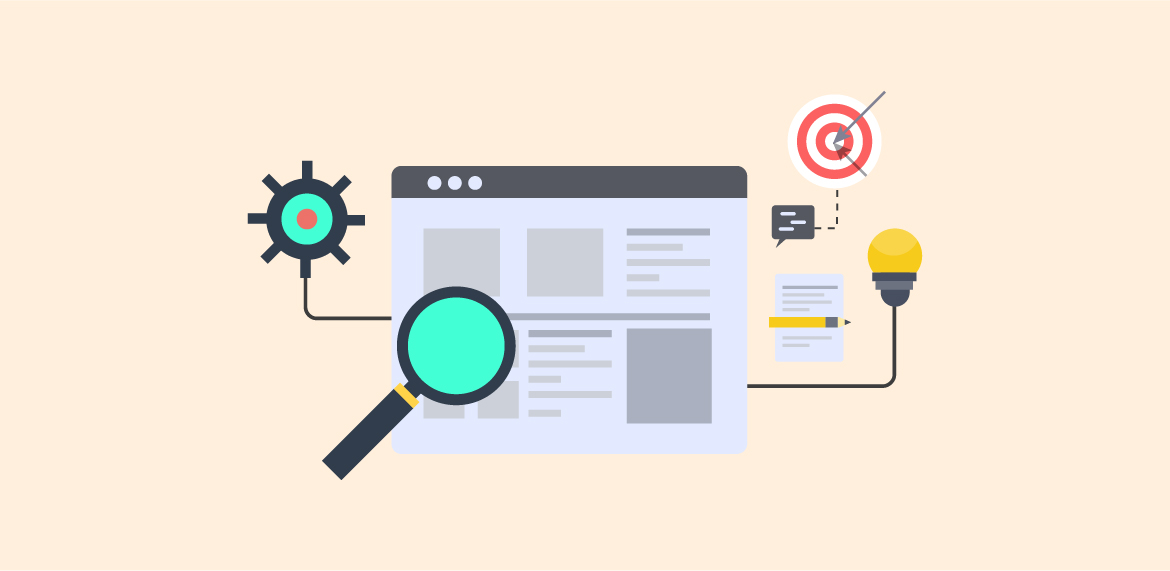- Content Writing
The Art of Persuasion: Writing Product Descriptions that Sell

Product Descriptions aren’t just some boring texts on ecommerce sites, they’re way more than that. Those little blurbs of texts are significant and offer a list of amazing advantages that can’t be overlooked in any way. From getting leads and conversions to helping online stores to achieve a higher rank on SERPs, their role is simply impactful.
Marketers and copywriters acknowledge the importance of product descriptions and know what works and what doesn’t when it comes to them. But in case you’re a newbie in the e-commerce industry, an amateur product description writer, or just don’t know enough about product descriptions, don’t worry, we have you covered.
In this blog, we’ll dive deep and explore everything about the product descriptions. So without further adieu, let’s get into it!
What are Product Descriptions?
A Product Description is a form of marketing copy that tells you all about the product. Typically it contains details about features, specifications, user instructions, and benefits. It can include specific and general pieces of information. They’re also called SEO Product Descriptions. Their text ranges from single or multiple sentences to a paragraph and also contains bullet points in most cases. Typically, they’re located right beside or under the product images and titles.
Indeed, product descriptions are an integral part of the sales funnel. Their prime goal is to deliver complete information and entice users to finally purchase the item. Well-thought-out, meticulously written, and interesting description contributes to the shopping experience, and increase customer retention and sales.
And on top of everything, SEO product descriptions help e-commerce sites to rank higher on SERPs and gain more traction. They contain the crucial keywords that match the user intent of your target audience. Like, a person types in the name of something they want to buy on Google, and they get different ecommerce sites on the SERPs. They check out your store and end up buying the product.
Product descriptions can be simple, profound, funny, quirky, to the point, etc. They can have a range of styles, so copywriters can pick the one that suits the businesses most.
So, you see writing product descriptions isn’t an easy breezy task. A lot goes in there. It’s not just some simple copywriting.
You’ll have to study the product and gather essential information. Like deciding what tone and format are the best? How long they’re supposed to be? Should they have bullets or not?
Let’s uncover essential tips on how to write a good product description. Here are the important things that you’re supposed to focus on:
Tips to Write Product Descriptions that Sell More
Before anything, focus on 3 things:
When you sit down to craft a winning product description, you need to focus on three things only before anything else.
- What major problems or issues your product has the capability to solve?
- In what ways your product benefits your target audience?
- How your product is just better than the rest?
Every good product description example you come across answers these questions. Have a look at this example, it answers all three questions above:
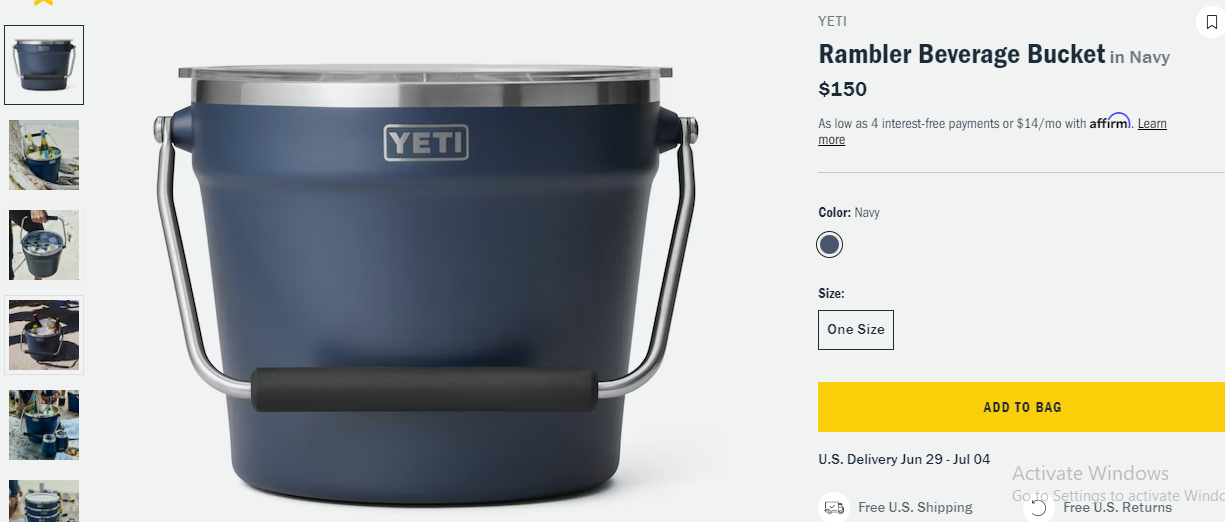

So, prioritize answering the important questions in your product descriptions. Not only does it provide value to the users but also lets them know what they want to know.
Know who your Target Audience is
Let’s get one thing straight, if you don’t know whom you actually writing for, you won’t be able to write a stellar product description. It’ll be a hard nut to crack!
So, put in some effort and time in knowing who your target audience actually is. By doing so, you’ll be able to comprehend your buyer persona on a deeper level and learn about their distinct characteristics. This will help you address their pain points, provide fitting solutions, and pick up the familiar tone and style for them. (Unless you don’t want to)
Collecting answers to the following questions will help you understand your target audience better:
- What intrigues your target audience?
- What interests them the most?
- Why your customer is interested to buy from you or your store?
- What features or benefits does your product offer that will instantly catch the attention of your target audience?
- How your customer will define your product to a friend or other people?
Use power words that sell
Power words hold the power to elicit a certain emotion from the readers. It might have happened to you as well, when you come across some description and it makes you feel some type of way, like, happy, excited, interested, or wanting to impulsively buy something, that’s what it’s all about.
Here’s the list packed with some power words curated by Jon Morrow.
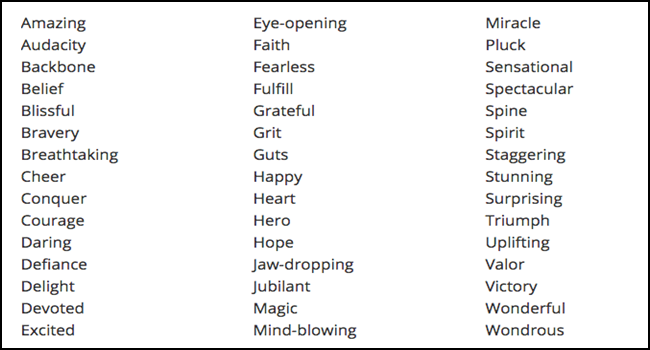
By incorporating these incredible power words into your description, you can communicate that your products are fun, functional, fine, impressive, just better than other options in the market, and totally worth your money.
Have a look at the product description of this Canvas Tote. In this example, you can spot the 2 power words, ‘limited edition’ and ‘all-in-one’.
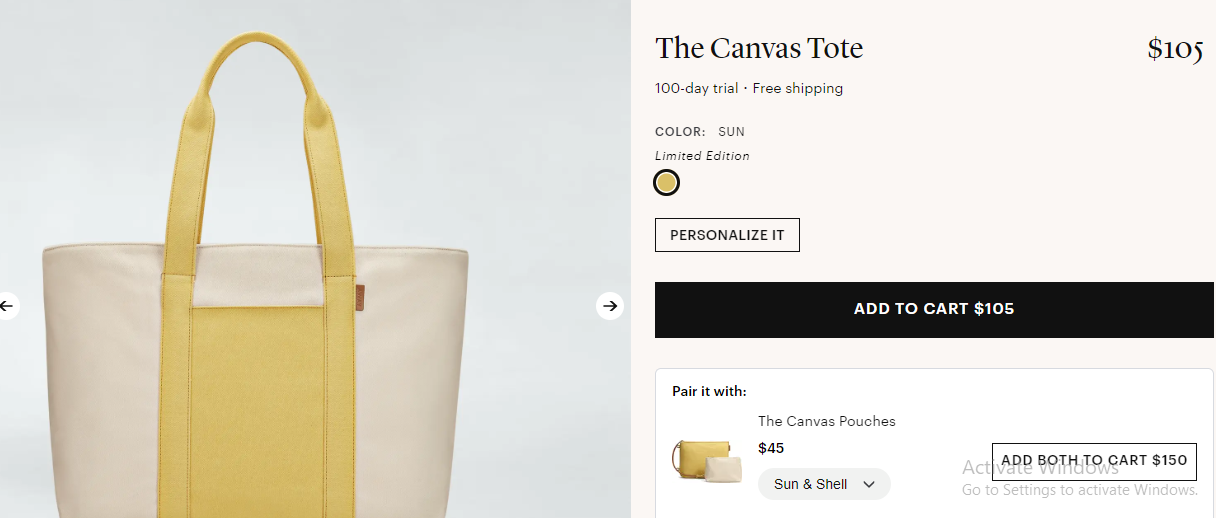
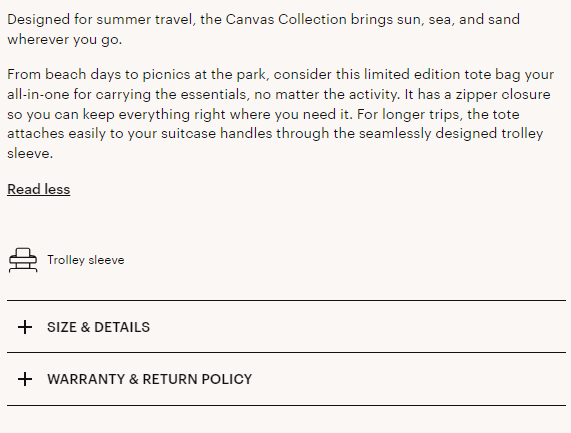
Another important thing is to use sensory words. They’re the power adjectives that magnify product experience for readers. If you have a clothing brand, you can use words like trendy, comfortable, fashionable, and high quality. In case you’re selling baked goods items, think of words like velvety, smooth, delicious, crunchy, etc.
For example, here’s the product description of Lush’s Orange Body Scrub. Note that there’s a use of sensory words, Zesty and Zingy, to describe its pleasant effect.

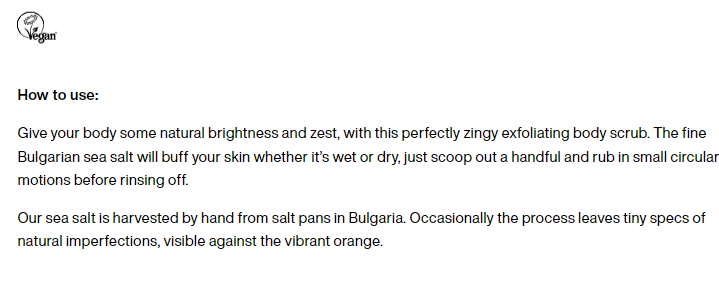
Talk about Benefits and Features
Here’s the thing, why would anyone be interested in your offered item if it has a bland, unclear, or incomplete product description? You, yourself won’t be interested in the product if you come across such a text. If it gives nothing interesting or important, no one will be interested in it.
Therefore, it’s utterly important to write information-filled product descriptions. Provide all the details from A to Z. Everything from benefits to selling features and unique traits. Explain to your readers how is it better than its counterparts, what it has got to offer, and why someone should spend their money on it. And they’ll spot its charm, value, and undeniable worth.
Have a look at this example of Nike Air Force’s product description. It is important to note that they explained benefits first but also didn’t ignore features (product details).
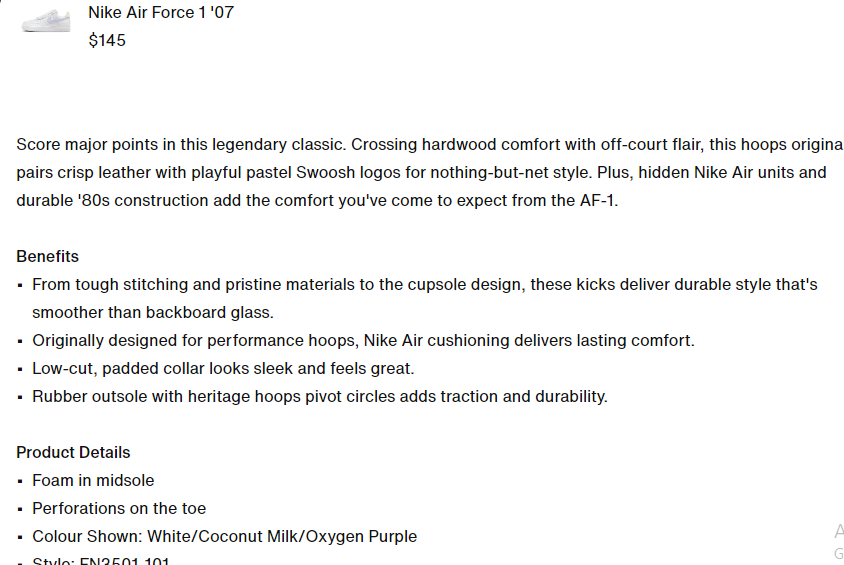
So, take time to know your product, only then you’ll be able to write accurate product descriptions. Make sure to create a balance between the benefits and features, so it communicates its full potential to users.
Optimize for Search Engines
It goes without saying that optimization for search engines begins with Keywords. In this particular case, they are the search terms associated with the products buyers are looking for and want to buy.
According to Shopify, there are four main areas where keywords must be incorporated for better rankings.
- Page titles
- Meta descriptions
- Image tags (called ALT tags)
- Product descriptions
So, it’s recommended to perform keyword research and list down the keywords which match your products. Then incorporate it into the titles and product descriptions. Don’t duplicate content or go for a generic description for every product. Otherwise, it can drop your SERP rankings. So avoid it.
Make it easy to scan
It is a fact that the attention span of people is getting shorter. They don’t spend more than mere seconds on something if they don’t find it interesting. So the more scannable your product description is, the better it is.
Make your product descriptions super scannable by,
- adding Big, bolded and headlines
- using short paragraphs
- including easy-to-read bullet points
- increasing or decreasing font size to aid readability
- using high-quality visuals
- incorporating an ample amount of white space
This will help online buyers to easily spot the details they’re looking for capturing their interest.
Add a Call to Action (CTA)
Don’t forget the last piece of the puzzle — the call to action. They help customers seamlessly transition to the final stage, which is making a purchase. CTAs should be direct, to the point, and clearly visible at the end.
You can use different CTAs, for instance, “Purchase Now”, “Add to Cart”, and a secondary CTA, like, “Add to Wishlist”.
Include Social Proofs
Ratings, reviews, and testimonials are a testament that a product is worth every buck. It increases the trust level among people and they’re more likely to make a purchase. According to a study, 63.6% of people do a Google search for reviews before making a purchase.

You can also use your socials to garner a plethora of reviews by encouraging customers to share their experience with the product.
In case you’re looking for one perfect product description template that can create descriptions for a variety of products, unfortunately, that’s not possible. However, you can create multiple templates for different categories of items by incorporating the tips above. That will simply do the job.
Conclusion
A well-thought-out and meticulously written product description acts like a powerful magnet to get you more conversions. It makes any product page appear more authentic, compelling and elevates the shopping experience overall.
This year, invest more time and effort into crafting compelling, authentic, and informative descriptions. And see your sales go up shortly!
Kickstart your first project
- Easy Order Process
- Vetted team of writers
- 100% original content


